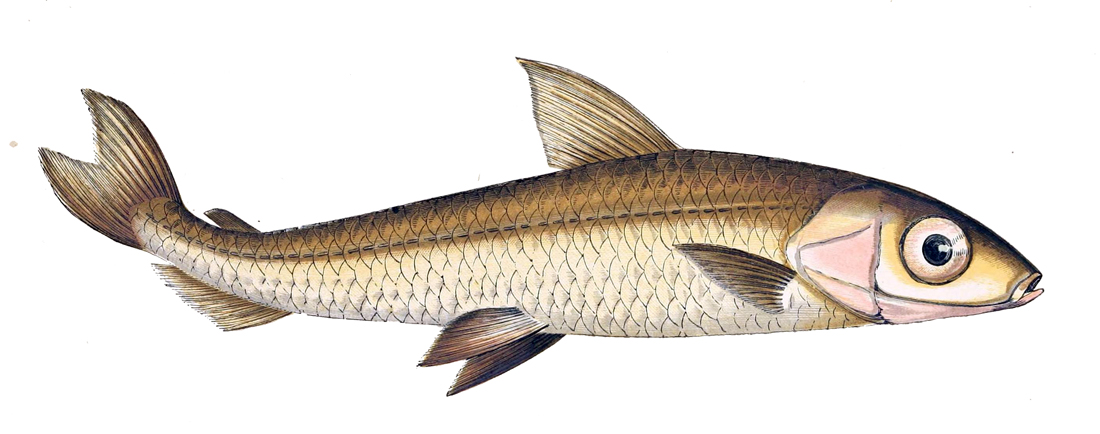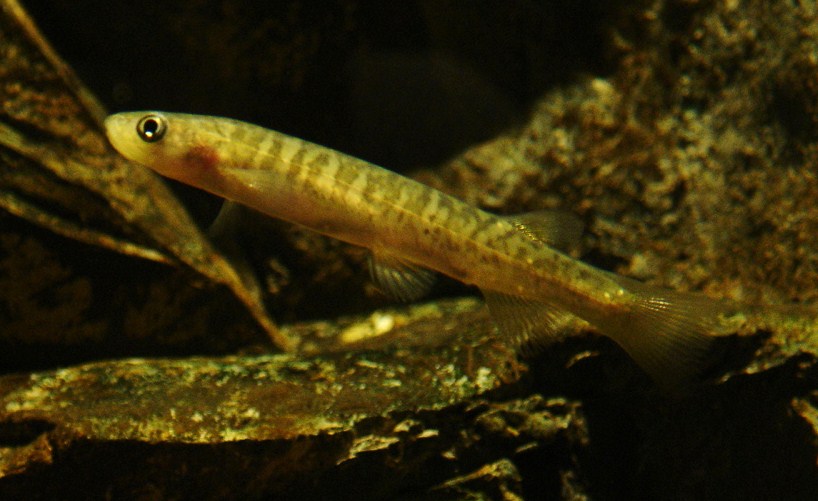|
Stomiati
Stomiati is a group of teleost fish belonging to the cohort (group) Euteleostei, which is a group of bony fishes within the infra-class Teleostei that evolved ~240 million years ago. Teleostei is a group of ray-finned fishes with the exception of primitive bichirs, sturgeons, paddlefishes, freshwater garfishes, and bowfins. The cohort of Euteleostei is divided into two smaller groups: the Protacanthopterygii and the Neoteleostei. Stomiati happen to be descendants of the Protacanthopterygii, and contains the order of Osmeriformes and Stomiiformes (Betancur-R, et al.). Stomiati is one of five major euteleost lineages that were recently placed in one monophyly, a group of organisms all descending from one common ancestor. The five being a clade formed by Esociformes and Salmoniformes; second being the Stomiatii consisting of only Osmeriformes and Stomiiformes; Argentiniformes (excludes Alepocephaliformes); Galaxiiformes (excludes '' Lepidogalaxias''); and Neotelestei. Stomiati ar ... [...More Info...] [...Related Items...] OR: [Wikipedia] [Google] [Baidu] |
Protacanthopterygii
Protacanthopterygii is a ray-finned fish taxon ranked as a superorder of the infraclass Teleostei. They inhabit both marine and freshwater habitats. They appear to have evolved in the Cretaceous or perhaps late Jurassic, originating probably roughly 150 million years ago; fossils of them and the closely related Otocephala are known from throughout the Cretaceous.Encyclopædia Britannica Online (2009): Annotated classification – Superorder Protacanthopterygii. ''In:'Fish Version of 2009-APR-22. Retrieved 2009-SEP-28. Characteristics and origin The Protacanthopterygii contain a number of moderately advanced teleosts. Anatomical and other traits commonly found in this superorder are: more than 24 vertebrae, epicentral cartilages, one supraorbital bone, and a mesocoracoid, an adipose fin, and (often prominent) glossohyal teeth. However, they usually lack a protrusible upper jaw, a gular plate, and proximal forking of the intermuscular bones. Most members of this taxon are rat ... [...More Info...] [...Related Items...] OR: [Wikipedia] [Google] [Baidu] |
Teleost
Teleostei (; Greek ''teleios'' "complete" + ''osteon'' "bone"), members of which are known as teleosts ), is, by far, the largest infraclass in the class Actinopterygii, the ray-finned fishes, containing 96% of all extant species of fish. Teleosts are arranged into about 40 orders and 448 family (biology), families. Over 26,000 species have been described. Teleosts range from giant oarfish measuring or more, and ocean sunfish weighing over , to the minute male anglerfish ''Photocorynus spiniceps'', just long. Including not only torpedo-shaped fish built for speed, teleosts can be flattened vertically or horizontally, be elongated cylinders or take specialised shapes as in anglerfish and seahorses. The difference between teleosts and other bony fish lies mainly in their jaw bones; teleosts have a movable premaxilla and corresponding modifications in the jaw musculature which make it possible for them to cranial kinesis, protrude their jaws outwards from the mouth. This is of ... [...More Info...] [...Related Items...] OR: [Wikipedia] [Google] [Baidu] |
Euteleostei
Euteleostei, whose members are known as euteleosts, is a clade of bony fishes within Teleostei that evolved some 240 million years ago. It is divided into Protacanthopterygii (including the salmon and dragonfish) and Neoteleostei (including the lanternfish, lizardfish, oarfish, and Acanthopterygii). The cladogram is based on Near et al. (2012) and Betancur-Rodriguez et al. 2016. They explored the phylogeny and divergence times of every major lineage, analysing the DNA sequences of 9 unlinked genes. They calibrated (set actual values for) branching times in this tree from 36 reliable measurements of absolute time from the fossil A fossil (from Classical Latin , ) is any preserved remains, impression, or trace of any once-living thing from a past geological age. Examples include bones, shells, exoskeletons, stone imprints of animals or microbes, objects preserved ... record. References {{Taxonbar, from=Q1378777 ... [...More Info...] [...Related Items...] OR: [Wikipedia] [Google] [Baidu] |
Teleostei
Teleostei (; Ancient Greek, Greek ''teleios'' "complete" + ''osteon'' "bone"), members of which are known as teleosts ), is, by far, the largest class (biology), infraclass in the class Actinopterygii, the ray-finned fishes, containing 96% of all neontology, extant species of fish. Teleosts are arranged into about 40 order (biology), orders and 448 family (biology), families. Over 26,000 species have been described. Teleosts range from giant oarfish measuring or more, and ocean sunfish weighing over , to the minute male anglerfish ''Photocorynus spiniceps'', just long. Including not only torpedo-shaped fish built for speed, teleosts can be flattened vertically or horizontally, be elongated cylinders or take specialised shapes as in anglerfish and seahorses. The difference between teleosts and other bony fish lies mainly in their jaw bones; teleosts have a movable premaxilla and corresponding modifications in the jaw musculature which make it possible for them to cranial kinesi ... [...More Info...] [...Related Items...] OR: [Wikipedia] [Google] [Baidu] |
Osmeriformes
The Osmeriformes are an order of ray-finned fish that includes the true or freshwater smelts and allies, such as the galaxiids and noodlefishes; they are also collectively called osmeriforms. They belong to the teleost superorder Protacanthopterygii, which also includes pike and salmon, among others. The order's name means "smelt-shaped", from ''Osmerus'' (the type genus) + the standard fish order suffix "-formes". It ultimately derives from Ancient Greek ''osmé'' (ὀσμή, "pungent smell") + Latin ''forma'' ("external form"), the former in reference to the characteristic aroma of the flesh of ''Osmerus''.Glare, P.G.W. (ed.) (1968–1982): ''Oxford Latin Dictionary'' (1st ed.). Oxford University Press, Oxford. FishBase (2006)Order Osmeriformes Version of 2006-OCT-09. Retrieved 2009-SEP-28. In the classification used here, the order Osmeriformes contains two suborders, six families, some 20 genera, and about 93 species. Other authors choose a slightly different arrangement, ... [...More Info...] [...Related Items...] OR: [Wikipedia] [Google] [Baidu] |
Galaxiidae
The Galaxiidae are a family of mostly small freshwater fish in the Southern Hemisphere. The majority live in Southern Australia or New Zealand, but some are found in South Africa, southern South America, Lord Howe Island, New Caledonia, and the Falkland Islands. One galaxiid species, the common galaxias (''Galaxias maculatus''), is probably the most widely naturally distributed freshwater fish in the Southern Hemisphere. They are coolwater species, found in temperate latitudes, with only one species known from subtropical habitats. Many specialise in living in cold, high-altitude upland rivers, streams, and lakes. Some galaxiids live in fresh water all their lives, but many have a partially marine lifecycle. In these cases, larvae are hatched in a river, but are washed downstream to the ocean, later returning to rivers as juveniles to complete their development to full adulthood. This pattern differs from that of salmon, which only return to fresh water to breed, and is descr ... [...More Info...] [...Related Items...] OR: [Wikipedia] [Google] [Baidu] |
Pachystomias Microdon
''Pachystomias microdon'', the smalltooth dragonfish, is a species of barbeled dragonfish Stomiidae is a family of deep-sea ray-finned fish, including the barbeled dragonfishes. They are quite small, usually around 15 cm, up to 26 cm. These fish are apex predators and have enormous jaws filled with fang-like teeth. They ar ... found in the oceans at depths of from . This species grows to a length of SL. This species is the only known species in its genus. Red Light Bioluminescence Production of far-red bioluminescence ''Pachystomias'' is one of three deep-sea fish that can produce red light bioluminescence, along with '' Aristostomias'' and '' Malacosteus''. In addition to producing blue light via postorbital photophores, ''Pachystomias'' also possess suborbital and preorbital cephalic photophores that are capable of producing far-red bioluminescence, with wavelength emissions of over 650 nm. Compared to other bioluminescent fish, ''Pachystomias'' has ... [...More Info...] [...Related Items...] OR: [Wikipedia] [Google] [Baidu] |
Aristostomias
''Aristostomias'' is a genus of barbeled dragonfishes native to the ocean depths in the Pacific, Atlantic and Indian oceans. Red Light Bioluminescence Production of red light bioluminescence Similar to other deep-sea organisms that are capable of producing red light bioluminescence, including '' Pachystomias'', ''Aristostomias'' has large suborbital photophores that produce red-shifted cold light. In addition, ''Aristostomias'' has postorbital photophores that emit blue-green light. Visual systems Most meso- and bathypelagic fish are only able to see shortwave light, as their retinae possess rods with rhodopsins sensitive to blue light. ''Aristostomias'' is able to detect red-shifted light, as their retinae have long-wave absorbing rhodopsins and porphyropsins that can detect wavelengths of up to 590 nm. ''Aristostomias'' can detect red light at distances of up to 2 meters, suggesting that detection is used primarily for close-range intraspecific communication and sho ... [...More Info...] [...Related Items...] OR: [Wikipedia] [Google] [Baidu] |
Stoplight Loosejaw
The stoplight loosejaws are small, deep-sea dragonfishes of the genus ''Malacosteus'', classified either within the subfamily Malacosteinae of the family Stomiidae, or in the separate family Malacosteidae. They are found worldwide, outside of the Arctic and Subantarctic, in the mesopelagic zone below a depth of . This genus once contained three nominal species: ''M. niger'' (the type), ''M. choristodactylus'', and ''M. danae'', with the validity of the latter two species being challenged by different authors at various times. In 2007, Kenaley examined over 450 stoplight loosejaw specimens and revised the genus to contain two species, ''M. niger'' and the new ''M. australis''. ''Malacosteus'' and the related genera ''Aristostomias'', ''Chirostomias'' and ''Pachystomias'' are the only fishes that produce red bioluminescence. As most of their prey organisms are not capable of perceiving light at those wavelengths, this allows ''Malacosteus'' to hunt with an essentially invisible be ... [...More Info...] [...Related Items...] OR: [Wikipedia] [Google] [Baidu] |
Salangidae
Salangidae, the icefishes or noodlefishes, are a family of small osmeriform fish, related to the smelts. They are found in Eastern Asia, ranging from the Russian Far East in the north to Vietnam in the south, with the highest species richness in China. Some species are widespread and common, but others have relatively small ranges and are threatened. Depending on species, they inhabit coastal marine, brackish or fresh water habitats, and some are anadromous, only visiting fresh water to spawn. Appearance and life cycle They are slender, have translucent or transparent bodies and almost no scales (females are entirely scale-less, while males have a few). The head is strongly depressed and has numerous teeth. The adults are believed to be neotenic, retaining some larval features. For example, the skeleton is not fully ossified, consisting largely of cartilage. They are small fish, typically around long; only a few reach , and the largest species no more than . Icefish rapidly rea ... [...More Info...] [...Related Items...] OR: [Wikipedia] [Google] [Baidu] |
European Smelt
The smelt or European smelt (''Osmerus eperlanus'') is a species of fish in the family Osmeridae. Shape and appearance The body of the European smelt is typically 15 to 18 cm long, slender and slightly flattened on either side. Larger fish may reach 30 cm in length. Smelts have a slightly translucent body. The back and sides are grey-green to pink in colour, the flanks bright silver. The tailfin has a dark border. The smelt lives for up to six years. One characteristic is its intense smell, reminiscent of fresh cucumbers. Habitat and life The smelt is a sea fish that lives in the coastal waters of Europe from the Baltic Sea to the Bay of Biscay. A freshwater form, known in Germany as the ''Binnenstint'' ("Inland smelt"), is common in the larger lakes of Northern Europe. The smelt gather and swim about in the underflows of stronger currents in order to spawn above areas of sand. This takes place from the end of February to March, if the water temperature is above 9 ... [...More Info...] [...Related Items...] OR: [Wikipedia] [Google] [Baidu] |






.jpg)